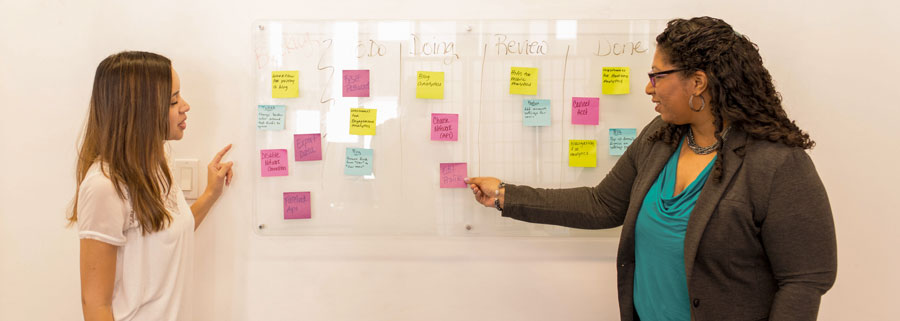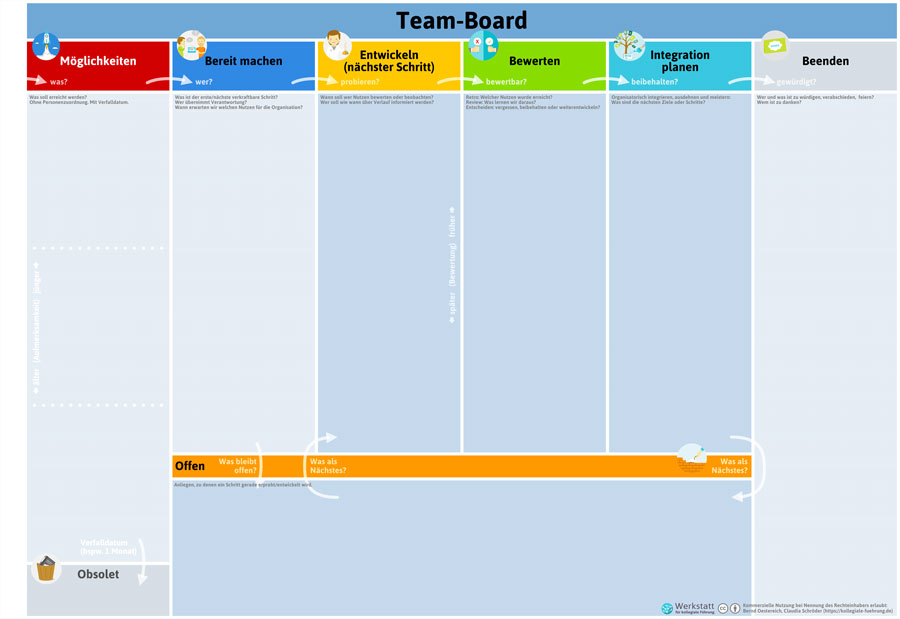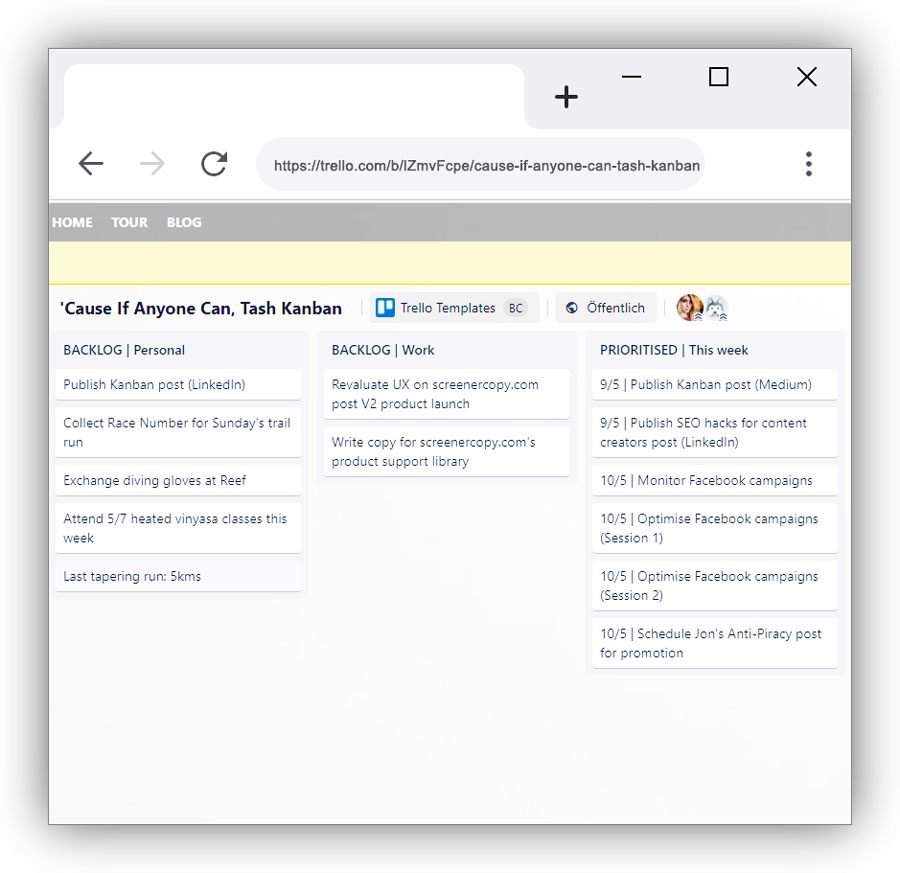
Agile Working: Kanban Offers Flexibility and Transparency for Innovation Projects and Open Science
Could more agile working in libraries and other information institutions make a contribution towards the successful implementation of innovation projects and Open Science? The project management method Kanban offers an easy entry to the topic of agility. See for yourself! We present the essentials of this popular method, which can be flexibly deployed in the most varied projects.
by Birgit Fingerle

Kanban is a relatively new, lean project management method in which you can organise projects easily and clearly. It has become popular thanks to digital Kanban apps such as Trello. Like Scrum, Kanban is a project management method that puts agile philosophy into practice. Both approaches help to develop better products (and services) more smoothly. Among other things, they both feature the independent working of teams. In contrast to Scrum, however, Kanban does not assign any fixed roles in the team. Of the two, Scrum is the more comprehensive and static concept. Kanban is simpler and, at the same time, a powerful way of optimising processes. Kanban is also more flexible because here tasks can be continually entered, prioritised, assigned and updated where required.
Visualisation and avoidance of multitasking with Kanban
The central principles of Kanban are the visualisation of tasks and the limitation of the number of tasks performed simultaneously. To do this, a Kanban board is used. The visualisation of the work process creates a high level of transparency and this alone already contributes to the greater probability of the goals being reached.

Limiting the number of tasks that can be carried out in parallel, and thereby avoiding multitasking, leads to an even workload and to faster the carrying out of the individual tasks. Problems that lead to bottlenecks are seen rapidly using this method. This in turn avoids overload and productivity is retained. Kanban is thus a tool for diagnosis and insight. Transparency is one of its greatest strengths.
Kanban boards bring transparency to work tasks
Tasks to be completed are represented in the form of cards and organised in a Kanban board. On the board, the workflow phases are displayed as columns. The cards pass through these columns one after the other, while the respective task defined on them is processed. The team determines its own “work in progress” limit for every column, that must not be exceeded. It stipulates how many work packages can exist simultaneously in one work step. This means that the number of parallel tasks that will be processed simultaneously in the team is limited. Only when there is enough free room in a column, can a finished element from the previous column be moved across and processed further. This prevents the overloading of the team or individual team members and keeps everything flowing. Bottlenecks in the process stand out immediately. A work package that is not accepted for a long time causes a queue in the previous steps. This problem can then be immediately analysed and remedied. The Kanban board documents the respective current status of the project. Using the Kanban board, the team analyses the status of the tasks and the problems occurring (on a daily basis, ideally). The team members assign themselves tasks independently according to the “Pull Principle”, namely by taking them and moving them forwards on the board.
As a Kanban board is an instrument to raise the information transparency, it should be visible in a central place at all times for the whole team. The original Kanban board displayed the columns
- „to do”,
- „in progress”
- and “finished”.
Numerous variations of these columns are possible, for instance
- „is being written“,
- „is being drafted“,
- and „technical examination“.
For your own project, you can create the columns that help you to visualise the individual steps from planning to realisation.
With a physical Kanban board in the room, the tasks are usually written on slips of paper, mostly adhesive notes. These Kanban cards then follow their path through the Kanban columns. This means that every participant can see the current condition of the respective task at all times. The Kanban cards contain important details about the task at a glance: a short description of the task element with details of the person responsible, due date and status. The cards can contain further information such as referrals to source documents or a list with factors that could stop the further progress of the task elements.
In the team, alone and for different purposes: Kanban is versatile
The Kanban project management method is also impressive through its versatile deployment possibilities. It can be adapted to the most varied industries and areas of activity: From manufacturing to the retail sector. Kanban is frequently used in support or maintenance teams and in customer service. This method is also suitable for the planning of publications or events.
Individuals can also plan their tasks with “personal Kanban”. It is also possible to represent several projects on one board without any problems: Either you supplement the board with additional rows (swim lanes), that are each assigned to a specific project, or you can use Kanban cards in different colours.
For some applications it can be useful to combine Kanban with Scrum. The well-known mixed forms of the two agile project management methods include Scrumban and Kanplan.
Tools for agile working with Kanban
Physical boards have the advantage that they are always displayed, at least as long as you are there on site. For remote teams, particularly in times of the COVID 19 pandemic, or for people with illegible handwriting, they are not ideal however. This is where the advantages of online tools come into play.
The advantages of digital Kanban boards are that they are quick to set up, easy to share with others, and offer the ability to track an unlimited number of comments asynchronously throughout the project. Team members are shown the current project status on Kanban board at all times.
Trello is a very well-known digital tool for setting up and processing Kanban boards. What’s more, Trello is also suitable for the organisation of personal tasks. There are also many other Kanban apps, of which Meistertask and Kanban Tool represent only a small selection. Open Source solutions include Restyaboard and WeKan.
First steps using Kanban in practice
Kanban is a really simple method. Just make a start by setting up your first Kanban board. If you don’t have a suitable work project, how about a private project? Perhaps you could organise a trip with Trello or another tool, or plan the necessary steps to learn a new language on a Kanban board at home on the wall in your living room.
The Teamboard (German), also known as “Führungsmonitor”, can also be a good way to start agile working, (see Oestereich, Bernd; Schröder, Claudia; Agile Organisationsentwicklung (German); Vahlen, 2019, S. 88 ff.).

Teamboard, this grafik is licensed und the Creative Commons “CC BY SA 4.0.
Commercial use permitted if the copyright holder is named: Bernd Oestereich, Claudia Schröder, Werkstatt für kollegiale Führung)
It is based on the Kanban idea but is actually a much simplified version and contains no prescribed “work in progress” limits. Despite this, the Team Board works in a similar way. As space in the columns is limited, columns can become bottlenecked here too, and thereby give an indication that they need attention. Like Kanban, it works according to the Pull Principle.
In contrast to Kanban boards or backlogs, the Team Board does not contain any regular work content but only content that is not part of everyday work or that would lead to organisational changes. All tasks that are not clarified or that appear unexpectedly, belong there. Team Board is useful for observing and pressing these management-relevant activities together. It is a simple way to create a permanent overview of the status of decision needs in an organisation or organisational unit, which can be updated regularly. It offers an easy way to incorporate new decision requirements in an organisation. In this respect, it supports the transformation process itself.
Simplicity and transparency make project organisation easier with Kanban
The many advantages of Kanban boards include significantly reduced communication effort and the fact that a goal becomes a public obligation. Furthermore, goals attained motivate team members to take on new activities and regular exchange promotes creativity. The active participation of everyone and continuous improvement are important values in Kanban. Kanban not only makes it easier for teams to organise themselves but it is also fun to be able to follow the progress so transparently and tangibly.
It is therefore worth trying out Kanban, in order to advance Open Science, innovation projects or the organisation as a whole. As a visual tool that is geared towards creating transparency, it also leads to the practice of more openness in the implementation of Open Science itself.
You may also find this interesting
- Agile working: Promoting innovations and Open Science with Scrum .
- Tool Collections: Choose the Right Tools for Digital Collaboration and Learning.
- Libraries and online events, part 3: How online workshops encourage new ideas and collaboration.
This text has been translated from German.
Birgit Fingerle holds a diploma in economics and business administration and works at ZBW, among others, in the fields innovation management, open innovation, open science and currently in particular with the “Open Economics Guide”. Birgit Fingerle can also be found on Twitter.
Portrait, photographer: Northerncards©
View Comments

Digitisation in Libraries: To What Extent has Corona Given a Boost?
The impact of the corona pandemic has been a huge challenge for libraries, institutes...




